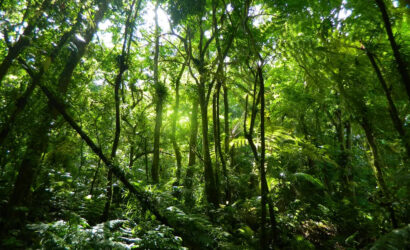Discover
Amazonas
Talking a little about
Amazonas is an immense state in the northwest of Brazil, covered almost entirely by the Amazon rainforest. The capital, Manaus, is a river port with landmarks dating back to the late 19th-century rubber boom, including the Teatro Amazonas, a grand opera house. The city marks the “Meeting of the Waters,” where the blackwater Rio Negro and the whitewater Rio Solimões come together to form the Amazon River.
Region
North
Population
4 million inhabitants
Climate
Equatorial and monsoon tropical.
Main attractions
Boat trips, trails, and ecological visits.

Some
Curiosities
The Amazon River is the second longest river on our planet, trailing only the Nile River. Its length is so vast that it’s nearly the same distance between the center of Brazil and the center of Mexico! Moreover, there are researchers who contest this information, even reclassifying the source of the Amazon, which could potentially make it even longer than the Nile!
The Amazon River originates in Peru and flows into the Atlantic Ocean, joining the Tocantins River in northern Brazil. Additionally, it is divided into three sections:
- In the Andean countries, it is called the Marañón River;
- Upon entering Brazil, it is known as the Solimões River;
- After receiving the waters of the Rio Negro, it becomes the Amazon River.
Lastly, it’s important to remember that, even though it might not be the world’s largest river, there’s another incredible aspect of the Amazon River: being surrounded by the largest tropical rainforest in the world, it possesses one of the highest levels of biodiversity among rivers anywhere on planet Earth!
Still talking about curiosities about the Amazon Rainforest, let’s discuss something unique: its waters. The word “pororoca,” of Tupi origin, means “causing a loud noise,” and it’s used to describe one of the most remarkable natural phenomena, which occurs when the sea invades a river in the form of a large wave that crashes against the river’s current.
The pororoca, this giant wave, can reach heights of up to 4 meters and last for up to an hour and a half, advancing up to 50 kilometers upstream! In the Amazon Rainforest region, this phenomenon usually occurs at the mouth of the Amazon River.
Did you know that many surfers dare to ride the pororoca? Even highly experienced surfers who participate in big wave competitions say that surfing the pororoca is very challenging. This is because, unlike ocean waves (which last a maximum of 40 seconds), the pororoca can be surfed for over an hour, making it extremely exhausting. As a result, it can even be more dangerous than a giant ocean wave!
The anaconda, also known as the sucuri, is one of the most prominent residents of the Amazon Rainforest. 🐍 It is considered the largest snake in the world in terms of weight and length ratio, reaching up to 9 meters in length and weighing as much as 135 kilograms!
The anaconda is such a remarkable animal that it has made its way onto the movie screens, with four titles to its name, the first of which was released in 1997. It might seem frightening, right? However, you should know: the anaconda is a fascinating creature! Despite its immense size, it is not venomous, which sets it apart from other smaller snakes. The real concern, though, lies in its bite: it is so powerful that just one bite is enough for the anaconda to kill its prey!
Among the curiosities about the Amazon Rainforest, its native peoples cannot be left out, right? According to the 2010 Census by the Brazilian Institute of Geography and Statistics (IBGE), there are approximately 306,000 indigenous people living in the Amazon, with the majority of the population residing in rural areas.
Some of the tribes of the Amazon Rainforest include:
Guarani; Xerente; Amawáka.
Wrapping up our list of curiosities about the Amazon Rainforest are the insects! Did you know that in the Amazon Rainforest, there’s a centipede that feeds on frogs, birds, and even snakes? It’s the Giant Centipede, which besides consuming crickets, can eat mice and other animals much larger than itself. Moreover, it can live up to 10 years!
Another fascinating insect that inhabits the Amazon Rainforest is the Goliath Bird-Eater Spider. It is the largest spider in the forest, with an average leg span of about 30 centimeters. Quite astonishing!
Some of our
itineraries
EXAMPLE Rio de Janeiro with a stay in the Amazon Jungle + a paradise beach.An essential itinerary that will take...







